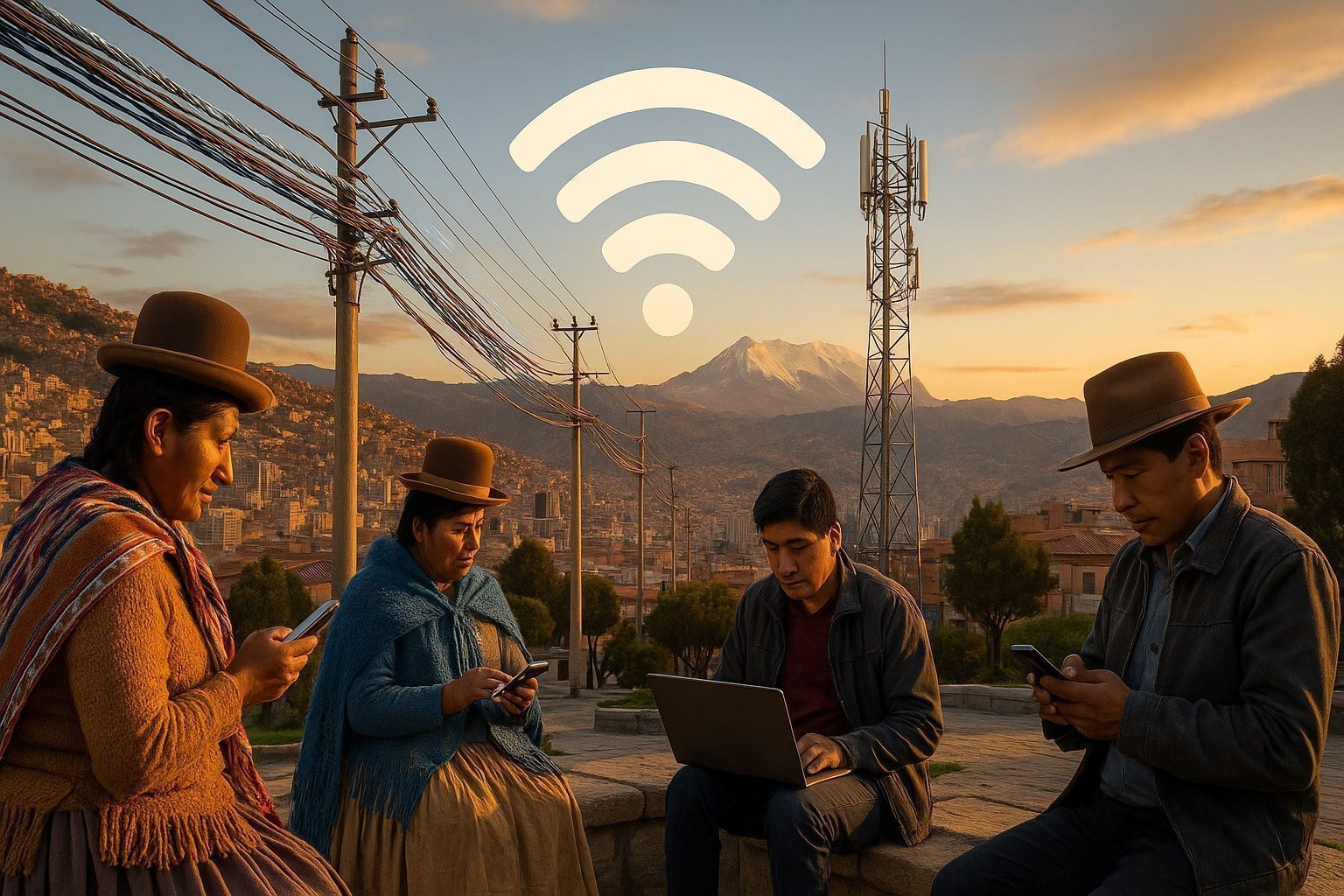- TKSat-1, launched in 2013 as a $300 million geostationary satellite with China’s help, enabled rural internet, backhaul for mobile towers, and community telecenters with latency around 600 ms.
- Plans for Túpac Katari 2 with substantially higher throughput were discussed, but a second satellite had not materialized by 2025.
- In August 2024 Bolivia banned unlicensed Starlink terminals, yet by early 2025 an estimated 10,000 Starlink kits were in use on the gray market, often roaming from Peru, with about $50/month and $500 equipment.
- The El Alto national data center opened in February 2025, a $52 million Tier III facility owned by Entel to host cloud services and cache popular local content.
- Bolivia had over 28,000 km of fiber optic backbone deployed by 2021, and by 2024 more than 90% of fixed broadband connections were fiber-based, with 77% of fixed connections in the central urban corridor.
- As of early 2025 there were about 8.77 million internet users, representing roughly 70.2% of the population.
- Bolivia registered 13.5 million mobile connections in 2025, about 108% of the population, with around 90% of internet users accessing online via mobile devices.
- Entel, the state-owned incumbent, held about 45% of the market, operates the widest mobile network with 4G, has fiber-to-the-home rollout since 2019, covers 219 of 340 municipalities, and offers basic fixed fiber plans around Bs 200–230 per month.
- Tigo, Millicom’s Bolivia, is the second-largest operator with about 41% market share, provides fixed broadband via HFC and fiber in urban centers, and its home internet is commonly around Bs 210 per month.
- Bolivia’s market is highly concentrated with Entel and Tigo accounting for over 85% of subscriptions; the Internet Society rates the market as very poor in competitiveness, and 5G deployments have not progressed beyond tests.
Bolivia’s quest to bridge its digital divide is a story of geography and innovation. This landlocked nation – with sky-high Andean peaks and remote Amazonian villages – faces unique challenges in expanding internet access. The government and telecom providers have had to lay fiber across rugged terrain, beam signals from satellites, and extend mobile towers to connect communities. As of 2025, internet penetration in Bolivia has grown rapidly, yet connectivity remains uneven between bustling cities and isolated rural areas. The following report explores Bolivia’s internet infrastructure, providers, affordability, policies, usage statistics, and recent developments that are shaping how Bolivians connect from the mountaintops to the satellites above.
Infrastructure and Availability: Urban vs. Rural Access
Bolivia’s internet infrastructure reflects a stark contrast between urban centers and rural hinterlands. In major cities like La Paz, Santa Cruz, and Cochabamba, residents increasingly enjoy high-speed connections via extensive fiber-optic networks and 4G mobile coverage. Over 28,000 km of fiber optic backbone had been deployed nationally by 2021, more than double the fiber length in 2013 [1]. This backbone links the country’s “central axis” cities, where most economic activity is concentrated. In fact, over 77% of Bolivia’s fixed internet connections are clustered in the central urban corridor [2], underscoring the heavy urban focus of infrastructure. Urban users typically have access to fixed broadband (fiber or DSL) as well as mobile data, supporting relatively stable connectivity in city centers.
By contrast, rural and remote areas face limited or no internet access. Only about 10% of Bolivia’s vast territory has mobile network coverage, largely around towns and highways [3]. In sparsely populated highlands and rainforest regions, many communities lie beyond the reach of fiber lines or cellular signals. It’s common for rural Bolivians to climb hills or trek to specific spots just to get a mobile signal [4]. As a result, there is a huge usage gap: approximately 78% of the urban population uses the internet, compared to just 38% in rural areas [5]. This urban–rural digital divide reflects the difficulty of extending infrastructure to villages separated by mountains, jungles, and low population density. The government has installed some microwave links and community telecenters in rural municipalities, but these efforts only partially cover the need. Even where a connection exists, rural users often contend with slower speeds and less reliable service than their urban counterparts due to older infrastructure or satellite links.
Internet Penetration and Usage Statistics
Bolivia has made notable strides in getting more of its people online in recent years. As of early 2025, there were an estimated 8.77 million internet users in Bolivia, equivalent to about 70.2% of the population [6]. This marks a sharp rise from an internet penetration rate of ~55% in 2022 [7], reflecting significant growth in connectivity. Driving this progress is the explosion of mobile internet usage: Bolivia had 13.5 million mobile connections in 2025 (about 108% of the population) – meaning many Bolivians now have mobile phones, often with multiple SIM cards [8]. Thanks to affordable smartphones and expanding 3G/4G networks, roughly 90% of Bolivians who access the internet do so via mobile phones [9] [10]. Mobile broadband subscriptions (3G/4G) reached 91% penetration by 2023 [11], indicating that virtually all internet users have some form of mobile data service.
Fixed broadband adoption, while growing, still lags behind. There are about 1.4 million fixed broadband subscriptions (home or business internet lines) in the country, representing roughly 42% of households [12]. The majority of these fixed connections – over 1.32 million – are now delivered via fiber-optic networks [13]. In fact, more than 90% of fixed broadband connections in Bolivia are fiber-based as of 2024 [14], a notable technological leap that bypassed legacy cable or DSL in many areas. Despite this, Bolivia’s fixed broadband penetration remains among the lowest in Latin America (regional average ~60% of households) [15]. The disparity means many Bolivian homes rely solely on mobile data for internet, or have no access at all if they live in remote zones.
Not only is access uneven, but speeds in Bolivia are the slowest in all of Latin America [16]. Average download speeds hover around 32 Mbps for fixed broadband and just 10 Mbps for mobile connections [17]. By comparison, neighboring countries enjoy higher averages, and Chile’s population online approaches 89% versus Bolivia’s ~70% [18]. The poor speed and quality of service have been a pain point – infamously highlighted when a visiting streamer, IShowSpeed, complained “There’s no internet in Bolivia” during a glitchy livestream from Santa Cruz [19]. While an exaggeration, his frustration underscores Bolivia’s struggle with latency and bandwidth. Factors like limited international fiber capacity, network congestion, and high elevation terrain all contribute to performance issues. Nevertheless, usage trends are up: more Bolivians are participating in the digital world each year, doing everything from social media (61% penetration) [20] to e-commerce and e-government services.
Major Internet Service Providers in Bolivia
Bolivia’s telecom market is a mix of state-owned and private operators providing internet through various technologies (fiber, mobile, satellite). Competition is limited, with two companies dominating most of the market [21]:
- Entel (Empresa Nacional de Telecomunicaciones) – The state-owned incumbent and largest provider. Entel offers fixed broadband (fiber and some ADSL) in all major cities and many towns, and it operates the widest mobile network (GSM/3G/4G) covering both urban and rural areas. Entel controls about 45% of the internet service market by subscription share [22]. On the fixed side, Entel has aggressively rolled out fiber-to-the-home (FTTH) since 2019 and claims coverage in 219 out of 340 municipalities [23]. Mobile-wise, Entel’s 4G signal reaches around 87% of the population (mostly in populated areas) [24]. It also provides connectivity to remote zones via the state satellite network. Entel’s broadband plans are often the most affordable (aimed at mass-market), though users report that some neighborhoods suffer from slowdowns when networks get saturated [25]. For instance, Entel’s basic fiber plan (advertised around 20 Mbps) costs roughly Bs 200–230 per month (~$30) in 2025, making it relatively accessible by local standards.
- Tigo (Telefónica Celular de Bolivia / Millicom) – A private telecom company owned by Millicom, Tigo is the second-largest operator with about 41% market share in internet services [26]. Tigo operates nationwide mobile services and also provides fixed broadband via HFC (cable modem) and fiber in urban centers. It was the first to launch 4G LTE in Bolivia (in 2013) and has 4G coverage in at least one city of every department [27]. Tigo’s home internet is popular in cities, often bundled with TV. Pricing is similar to Entel – Tigo’s “basic” internet package recently increased to Bs 210 per month (~$30) [28]. Many customers find Tigo offers somewhat more stable speeds than the competition [29]. Tigo also leads in customer service among the big providers, according to anecdotal reports. Its network upgrades in fiber have contributed to Bolivia’s high fiber share of fixed connections.
- Viva (Nuevatel PCS) – The third mobile operator, with a much smaller footprint (~4% market share in internet access) [30]. Viva (formerly NuevaTel) is a private company historically backed by Trilogy International. It offers 2G/3G/4G mobile services in larger cities and some towns, but its coverage and subscriber base are limited compared to Entel and Tigo. Viva does not have significant fixed broadband offerings; it focuses on mobile and some fixed wireless. In recent years, Viva has struggled to compete, and its market share has hovered in the single digits [31].
- AXS Bolivia – AXS is a local private ISP (originally an AT&T joint venture) that provides fixed broadband (fiber) and corporate data services in Bolivia’s main cities. It holds roughly 4% of the internet market [32], primarily serving enterprise and high-end residential customers. AXS has deployed fiber in business districts and offers plans with speeds up to 100 Mbps or higher to clients that demand reliable service. Its consumer presence is smaller, but it contributes to competition in the fixed broadband segment in La Paz, Santa Cruz, and Cochabamba. Prices tend to be premium, targeting businesses and affluent users.
- COTAS, Comteco, and other Cooperatives – Bolivia has a unique presence of regional telecom cooperatives that historically provided telephone services and now also offer internet in their areas. For example, COTAS (in Santa Cruz) and Comteco (in Cochabamba) run cable/fiber broadband networks in their respective cities. Comteco has about 3% market share nationally [33], while COTAS is a major player in Santa Cruz (its share is largely local). These co-ops offer broadband plans and bundles (including TV) to their members. Their service quality has varied – COTAS was once praised for service but later faced issues around 2015 [34]. Still, they increase consumer choice in those cities. In La Paz, a cooperative (COTEL) also exists but has had operational difficulties in recent years.
- Bolivian Space Agency (ABE) – “SUBE” Satellite Internet: To reach areas where no fiber or cell network exists, the government (through ABE) provides a satellite broadband service branded SUBE. This uses Bolivia’s own Túpac Katari 1 satellite in geostationary orbit. The SUBE service is truly nation-wide in coverage – even the most isolated village can connect with a satellite dish. Plans are metered by data: for example, a basic SUBE plan costs Bs 298/month ($43) for a 16 GB data cap [35], while higher plans offer 35 GB or 55 GB for up to Bs 828 ($120) [36] [37]. All plans allow unlimited usage during off-peak nighttime hours (midnight to 7am) [38] [39]. ABE provides the satellite equipment on loan with an installation fee (around Bs 800) [40]. Speeds on SUBE are modest (sufficient for basic web, messaging and SD video), and once the monthly data quota is consumed, speeds throttle to roughly WhatsApp-only levels [41] [42]. Thousands of households and community centers in remote Bolivia use this service, although the latency (~600ms) and cost per GB are much higher than terrestrial options.
Table 1: Key Internet Providers in Bolivia (2025)
| Provider | Service Type | Coverage & Availability | Typical Speeds & Tech | Example Pricing (Monthly) |
|---|---|---|---|---|
| Entel (state-owned) | Fixed (Fiber/ADSL), Mobile (2G/3G/4G) | Nationwide: present in all 9 departments; fiber in 219+ municipalities; widest mobile network (87% pop. coverage 4G) [43] [44]. Also offers satellite backhaul in remote areas. | Fiber plans up to 100 Mbps; ADSL in some towns; 4G mobile (average ~5–10 Mbps) [45]. Testing 5G in limited trials [46]. | Fiber broadband from ~Bs 200 ($29) for basic plan; Mobile data ~Bs 40 ($6) per 1 GB [47]. Low-cost packages aim for affordability. |
| Tigo (Millicom) | Fixed (Cable/HFC, Fiber), Mobile (2G/3G/4G) | Urban focus: fixed internet in major cities (La Paz, Santa Cruz, etc.); mobile network nationwide (all departments, mostly urban & highways) [48]. No service in some very remote areas. | Cable & fiber broadband up to 100 Mbps; launched LTE 4G (2013) with similar mobile speeds to Entel. Known for relatively stable network. | Home internet ~Bs 210 ($30) for base tier [49]; Mobile data ~Bs 55 ($8) per 1 GB [50] (30-day). Often sells bundles (internet+TV). |
| Viva (Nuevatel) | Mobile only (2G/3G/4G) | Selective coverage: main cities and towns. Smaller network footprint; no fixed-line services. Focus on prepaid mobile users. | 4G/LTE in core urban areas (launched later than rivals); 3G in secondary areas. Speeds comparable to other 4G networks where available. | Prepaid mobile data packs similar in price to competitors. (E.g. 1 GB for ~Bs 50). Viva targets budget users but limited coverage reduces reach. |
| AXS Bolivia | Fixed (Fiber) | Cities: La Paz, Santa Cruz, Cochabamba (business districts and upscale residential zones). Not in rural areas. | High-speed fiber offerings (50–200 Mbps or more) for enterprises; provides reliable dedicated links. | Premium pricing – significantly higher than mass-market plans. (E.g. business fiber 20 Mbps for several hundred Bs). Custom plans for corporate clients. |
| Cooperatives (COTAS, Comteco, etc) | Fixed (Fiber, Cable) | Regional: COTAS in Santa Cruz city/province; Comteco in Cochabamba; others in Oruro, Tarija, etc. Coverage generally within city limits or local area. | Upgrading from ADSL/cable to fiber. Speeds vary: many offer 10–50 Mbps plans, with fiber up to 100 Mbps in some areas. Quality can depend on local investment. | Prices comparable to Entel/Tigo in their regions (around Bs 200–300 for moderate speeds). Co-ops often bundle TV, and require membership or locality. |
| ABE “SUBE” (Satellite) | Fixed Satellite Internet (Ku-band) | Nationwide coverage (100% of territory) – available anywhere in Bolivia with line of sight to satellite [51]. Ideal for rural villages, farms, mines, where no other service exists. | High latency (~0.5s). Plans capped by data: speeds around 2–10 Mbps (suitable for basic web, messaging, some video). Unlimited usage at night (00:00–07:00) to compensate data limits [52] [53]. | Bs 298 ($43) for 16 GB basic plan [54]; Bs 828 ($120) for 55 GB “Avanzado” plan [55]. Equipment provided with one-time install fee (~Bs 800). Expensive per GB, used as last resort in remote areas. |
| Starlink* (SpaceX) | Satellite Internet (LEO) | Not officially available (service banned pending licensing). Unofficial use via kits from neighboring countries in some areas [56]. | High speed, low-latency satellite (~50–150 Mbps down, ~20–40 Mbps up). Performance often superior to local ISPs [57]. Requires clear view of sky; portable kit. | Service not legally sold in Bolivia. In neighboring Peru/Chile: ~$50/month + ~$500 equipment. Smuggled units used in Bolivia operate in roaming mode [58]. |
Table Notes: Starlink is included for comparison purposes given its emerging role, though it remains unlicensed in Bolivia as of 2025. Prices in USD are approximate, using 1 USD ≈ 6.9 Bolivianos. Mobile data pricing is for prepaid packages; postpaid plans with bundles are also offered by Entel/Tigo. All speeds are best-effort and actual performance varies by location and network conditions.
Pricing and Affordability for Users
Internet access in Bolivia is relatively expensive for the average citizen, especially by regional standards. A basic mobile internet package sufficient for light use costs around 3% of an average Bolivian’s monthly income [59]. This exceeds the UN affordability target of 2% of income for entry-level broadband, indicating that cost remains a barrier. For example, 1 GB of mobile data on a 30-day plan costs roughly Bs 40–55 (about $6–$8) on Entel or Tigo [60] [61]. A heavier user might spend Bs 140 ($20) for 6 GB or Bs 200 ($29) for 8 GB of mobile data [62] [63], amounts that quickly add up in a country where the monthly minimum wage is around Bs 2,250 (~$325).
Home broadband pricing also strains budgets. The cheapest fixed broadband plans (often around 6–10 Mbps) from major ISPs cost about Bs 200–210 per month (approximately $30) [64]. While these plans are unlimited data, $30 is a significant sum in a country with a GDP per capita near $3,500. Many families in rural or poor urban areas simply cannot afford a $30/month internet bill. In practice, this leads to scenarios where multiple neighbors share a single Wi-Fi connection or people rely solely on mobile prepaid packs when they can spare a few bolivianos for data. The urban middle class, on the other hand, increasingly views home internet as a necessity and absorbs the cost for work, study, and entertainment.
For the poorest communities, the government and municipalities have tried to provide free or subsidized access points. There are initiatives like free Wi-Fi zones in certain public plazas, bus terminals, and libraries in cities (e.g. La Paz’s “Chukuta Online” project) and some rural telecenters with internet access [65] [66]. However, these only cover small pockets and often suffer from slow speeds due to overuse. The Bolivian Space Agency’s satellite plans also reflect the cost challenge – while available everywhere, the SUBE satellite service charges high fees per GB, making it a last resort. At Bs 298 for 16 GB [67], a rural household would be paying over 10% of an average income for what amounts to moderate internet usage. Recognizing this, ABE gives unlimited off-peak data and allows smaller “top-up” packages (e.g. 1 GB for Bs 15) to stretch the value [68]. Even so, reports have labeled Bolivia’s internet “one of the most expensive in the region and one of the slowest”, underlining an urgent need for cost reductions [69].
The government has pledged to address affordability by various means. Regulators have discussed encouraging special low-cost plans for education and health uses [70] and leveraging the new state data center to cache content locally (reducing international transit costs). Thus far, tangible price drops have been limited, partly due to low competition. With essentially a duopoly in many areas, there is little market pressure to slash prices. Improving affordability likely requires policy interventions (such as subsidies, wholesale price controls on international bandwidth, or promoting a new competitor) alongside infrastructure investments to lower the cost per bit delivered.
Government Initiatives and Digital Inclusion Policies
The Bolivian government has acknowledged the digital divide and launched several initiatives over the past decade to expand internet access. However, efforts have sometimes lacked coordination or long-term consistency. As of 2024, Bolivia does not have a current comprehensive “digital agenda” or national broadband strategy in force [71]. A previous National Broadband Plan (Plan Nacional de Banda Ancha) was adopted in 2017 with a four-year horizon, but it concluded around 2021 without a clear successor plan [72]. That plan focused on building out the national fiber trunk network – for example, utilizing power utility rights-of-way to deploy fiber – and it led to the backbone doubling in length as noted earlier. It also aimed to connect all departmental capitals and many municipal capitals with high-capacity links.
To reach rural areas, the government uses the PRONTIS program (Programa Nacional de Telecomunicaciones de Inclusión Social) [73]. PRONTIS is funded by the telecom regulator’s universal service fund and invests in connectivity for underserved communities. Through PRONTIS, hundreds of small localities (particularly those with >2000 inhabitants as prioritized by 2017 resolutions) got resources for telecom infrastructure – such as installing cell towers, VSAT satellite terminals, or fiber drops to town centers. This helped some villages get their first internet labs and cell coverage. Still, as noted, many municipalities remained offline at the start of the COVID-19 pandemic [74], showing that PRONTIS and related efforts only scratched the surface. Bolivia’s Patriotic Agenda 2025 (a national development vision) had set a lofty goal of 100% connectivity by 2025 [75], which is unlikely to be met, but it spurred projects like the planned Túpac Katari II satellite (intended to greatly boost satellite capacity) [76]. Political changes and economic constraints have delayed some of these projects.
Under President Luis Arce (in office since late 2020), the government’s approach has been to strengthen state telecom capacity (via Entel and ABE) and make incremental regulatory improvements. In 2023, Arce announced a goal to extend fiber-optic broadband to every municipal capital (small town centers included) by the end of 2025 [77]. Backed by public investment, Entel is spending around $58 million to lay fiber in the remaining 116 municipalities that lack it [78]. By early 2025, Entel claimed to have fiber presence in 219 of 340 municipalities, and was on track to reach all by year-end [79]. This would ensure that each local district at least has a fiber node (e.g. at the local exchange or cellular base station), which can then be extended to homes or used for 4G/5G backhaul. The government also opened a $52 million national data center in El Alto in February 2025 [80] – a Tier III facility that will host cloud services and cache popular internet content within Bolivia. This data center, owned by Entel, should improve network performance and reduce dependence on international links for frequently accessed data.
Other policy steps include facilitating internet use in education and government services. During the pandemic, Bolivia struggled with online schooling due to patchy coverage. In response, there’s been a push to wire more schools with broadband (often via the satellite or fiber where available) and to train teachers in digital skills. The curriculum was revised in 2023 to include more digital literacy, although implementation faced opposition and challenges [81] [82]. Additionally, an initiative launched in 2022 called “Programa de Reducción de Brechas Digitales” (Program to Reduce Digital Gaps) aims to address gender and geographic disparities in ICT access [83]. This program, led by the Agencia de Gobierno Electrónico y Tecnologías de Información (AGETIC) with UNICEF, is focusing on providing devices, STEM education, and training in rural areas, especially for girls and women who are underrepresented online.
On the regulatory front, Bolivia’s telecom authority ATT has been working on modernizing telecom laws to accommodate new technologies. An important area is the regulation of satellite internet and low-earth-orbit (LEO) constellations (like Starlink), which previously didn’t fit neatly into licensing categories. By late 2024, ATT indicated it was “promoting more dynamic and transparent regulations to lower bureaucratic barriers” for wireless communications [84], partly in reaction to the Starlink issue. However, officials also emphasize that any company must comply with local licensing and work with the state’s oversight [85] – a stance that has caused friction with service models that bypass government infrastructure (discussed more below). Overall, Bolivia’s government initiatives reflect a balancing act: trying to extend coverage via state-led investments and inclusion programs, while also grappling with how to integrate global tech solutions within its regulatory and political framework.
Challenges to Internet Access in Bolivia
Despite progress, Bolivia faces significant challenges in achieving universal, high-quality internet access:
- Difficult Geography: The Andes mountains, high altiplano plains, and vast Amazonian lowlands make building infrastructure extremely challenging. Laying fiber or cables in mountainous terrain and dense rainforest is costly and slow. Many small villages are hours or days from the nearest city, complicating maintenance and repairs. The high altitude in places like El Alto (4,000m elevation) can also affect signal propagation and requires robust equipment. Geographic isolation is a core reason why only 10% of Bolivia’s land area has cell coverage [86] and why dozens of towns still rely on satellite links.
- Low Population Density in Remote Areas: Large parts of Bolivia are sparsely populated (e.g. the Amazonian Beni and Pando departments). The economic incentive for private operators to extend networks to these areas is low, since there are few paying customers to recoup infrastructure investments. Even with state subsidies, reaching the last 10–20% of the population involves high cost per user. This results in a persistent urban-rural gap where rural inhabitants (often indigenous communities) have far less access to information and services. According to the Internet Society, Bolivia’s rural internet usage is about half the urban rate [87], mirroring a common pattern in Latin America [88] but exacerbated by Bolivia’s terrain.
- Infrastructure Gaps and Quality: In areas that are technically “covered,” the quality of service may be poor. Many city neighborhoods suffer from network congestion – for instance, if an Entel fiber node is oversubscribed, users experience slowdowns during peak evening hours [89]. Some smaller towns are still on older DSL or even 2G/Edge mobile, which cannot support modern broadband applications. Power outages and lack of backup power in rural towers also cause interruptions. Moreover, Bolivia’s international bandwidth constraints affect everyone: being landlocked, Bolivia must buy internet transit from fiber routes through Peru, Chile, Brazil, or Argentina. This dependency historically kept bandwidth prices high; in 2022, the wholesale cost of international bandwidth for Bolivia averaged about $2.90 per Mbps [90] – higher than for coastal neighbors. Although prices have declined with new regional fiber projects, the country is still effectively an “internet island” relying on neighbors’ cables, which can bottleneck traffic and raise latency.
- Affordability and Poverty: With about 37% of Bolivians not using the internet at all [91], cost is a major barrier alongside availability. Bolivia is one of South America’s poorer countries, and many people must prioritize basic needs over data plans or broadband subscriptions. Where coverage exists, high prices for devices and services mean poorer households either remain offline or use the internet sparingly. Rural poverty is especially acute – even a subsidized $10/month plan would strain many rural family budgets. This leads to reliance on public access (like telecenters or a neighbor’s Wi-Fi) rather than private subscriptions. The government’s acknowledgment that internet is still too expensive [92] highlights that economic inequality translates into digital inequality.
- Limited Competition: Bolivia’s telecom market concentration contributes to the challenges. Entel and Tigo together command over 85% of internet subscriptions [93], effectively a duopoly. The third mobile player (Viva) is marginal, and other fixed providers cover only niche segments. The Internet Society rates Bolivia’s market “very poor” in competitiveness [94]. This lack of strong competition can lead to higher consumer prices, less incentive to improve customer service, and slower network upgrades. For example, 5G networks have not been deployed beyond tests, possibly because the incumbents are focusing on monetizing 4G and fiber investments first without competitive pressure to rush into 5G. Additionally, the state’s ownership of Entel means the government has a dual role as promoter and market actor, which may dissuade entry of foreign telecom investors and new competitors.
- Regulatory and Political Factors: Bolivia’s policy environment has sometimes prioritized state control over rapid innovation. A prominent example is the handling of Starlink and other satellite providers – the government banned unlicensed Starlink terminals in 2024, partly to protect the domestic satellite program and enforce regulations [95] [96]. While ensuring compliance is valid, this stance can also delay the introduction of cutting-edge services that could benefit consumers. There is a tension between sovereignty (keeping critical communications under national oversight) and the globalization of internet tech (like global LEO constellations). Political instability in past years (e.g. changes of government in 2019) also disrupted long-term planning for digital expansion. Moreover, bureaucracy and centralization mean projects like rural fiber or school connectivity can get bogged down in administrative hurdles.
- Digital Literacy and Relevant Content: Finally, beyond physical access, Bolivia faces a digital skills and content gap. Many people in underserved areas lack the training to use the internet effectively or there is a dearth of content in indigenous languages that would make the internet relevant to them. The gender gap is notable too – fewer women use the internet than men, particularly in rural communities [97]. Addressing these “soft” challenges is part of achieving true digital inclusion, alongside building the hard infrastructure.
Each of these challenges is substantial on its own; together, they paint a picture of why connecting all of Bolivia is difficult. Still, the trajectory is upward, and the hope is that continued investment, coupled with emerging technologies, can overcome the barriers in the coming years.
The Role of Satellite Internet: From Túpac Katari to Starlink
Satellites play a pivotal role in Bolivia’s connectivity strategy, given the country’s tough geography. In 2013, Bolivia launched its first communications satellite, Túpac Katari 1 (TKSat-1), with China’s assistance [98]. This $300 million geostationary satellite (named after an 18th-century indigenous hero) was a game-changer: it allowed Bolivia to beam internet, telephony, and television signals to far-flung rural areas for the first time [99] [100]. The primary mission of Túpac Katari 1 was “to provide communications to people who did not have communications in rural areas,” explained Iván Zambrana, the director of the Bolivian Space Agency [101]. Indeed, the satellite has been used to extend mobile networks (backhaul for remote cell towers) [102], deliver direct internet to community telecenters, and broadcast educational TV to villages. By leasing capacity on TKSat-1, the state telecom Entel quickly connected hundreds of previously disconnected localities in the 2010s. Zambrana noted that while urban areas now have fiber and other stable infrastructure, even cities utilize the satellite in some measure, and in rural Bolivia it remains a lifeline [103].
However, satellite internet via TKSat-1 has limitations: bandwidth is limited and latency high (~600 ms), and users often experience “patchy” connectivity [104]. As demand grew, Bolivia found itself looking to augment satellite capacity. Plans for Túpac Katari 2 with much higher throughput have been discussed (with China likely to partner) [105], but a second satellite has not materialized as of 2025. In the meantime, the world has seen the rise of LEO satellite internet constellations – namely SpaceX’s Starlink, which offers broadband from low Earth orbit with low latency and high speeds. Starlink began expanding service across Latin America in 2022–2024, and it tantalized Bolivians frustrated by slow terrestrial internet.
A clash ensued between Bolivia’s regulatory stance and users’ desire for Starlink. In mid-2023, SpaceX entered talks (facilitated by the U.S. Embassy) to get Starlink authorized in Bolivia [106]. Bolivian officials apparently set conditions – possibly involving partnering with a local entity or routing traffic via the national network – which SpaceX resisted, as it prefers a direct-to-consumer model [107]. Negotiations broke down, and by August 2024, Bolivia outright banned Starlink by denying it a license and warning that unlicensed equipment would be “disabled” [108]. The government’s public rationale was that companies must follow the rules and that Starlink’s entry should not negatively impact Bolivia’s communications system [109]. Privately, there were concerns about losing revenue from the state satellite (which Entel and others pay for bandwidth) and ceding control of critical infrastructure to a foreign company. As Néstor Ríos, director of regulator ATT, stated, “companies wishing to operate in Bolivia must comply with ATT regulatory standards, including obtaining licenses and permits.” [110] This cautious approach, however, did not sit well with many Bolivians in dire need of better internet.
Despite the ban, demand for Starlink in Bolivia exploded on the gray market. Enterprising individuals started smuggling Starlink kits across the Peru and Chile borders, where Starlink is legal and active [111]. Online forums and Facebook pages sprang up with offers to deliver Starlink equipment into Bolivia for a fee [112]. According to one Bolivian content creator, Ricardo Guillén, Starlink’s regional roaming mode allows the dish to work in Bolivia if it’s registered in Peru – at least for limited periods [113]. Guillén, based in a jungle village, managed to obtain a Starlink dish delivered to him from Peru and showcased an unboxing on YouTube [114]. He found the service transformative: “Starlink’s speed is incredible, and the word ‘unlimited’ means we can work, download, upload without stopping,” he said, noting it was “better than some fiber optic services available in La Paz.” [115]. His only struggle was paying the $50 monthly fee under Bolivian banking restrictions – intermittent payments caused service gaps, but each time the roaming could be reset to work again [116].
Guillén estimated there were around 10,000 Starlink kits in use in Bolivia by early 2025 [117] – an astonishing number given the service isn’t officially available. These range from remote eco-tourism lodges that abandoned the slow state satellite internet [118], to cattle ranchers monitoring livestock, to even urban remote workers who keep a Starlink for backup connectivity [119]. Essentially, Bolivians who can afford it and absolutely require reliable internet have taken matters into their own hands, regulations be damned. Bolivia is not unique in this: across parts of Africa and Asia where governments have been slow to approve Starlink, citizens have quietly imported it to bypass spotty internet and pricey local providers [120].
The Bolivian government is now in a tough spot. Technologically, Starlink (and upcoming competitors like OneWeb or Amazon’s Project Kuiper) could solve many connectivity issues for remote Bolivia. Politically and economically, the government wants sovereignty over communications and to ensure fair competition. Lawmakers have started to push back – for example, opposition legislator Mariela Baldivieso has campaigned to “regularize Starlink”, arguing that fast internet is essential and delays are untenable [121]. She formally requested an explanation from regulators about the Starlink ban in late 2024, though she hadn’t received a response yet [122]. The ATT has hinted it may ease rules for LEO satellite operators, possibly creating a new license category that could let Starlink operate legally [123] [124]. As of early 2025, however, no resolution has been announced – Starlink remains officially illegal, even as its dishes quietly proliferate in the countryside.
In the meantime, Bolivia continues to rely on TKSat-1, which is approaching its design end-of-life by 2028 [125]. The future of Bolivia’s satellite strategy might involve either launching TKSat-2 (with far greater capacity, as envisioned to have 10× the bandwidth of the first) or embracing international solutions like LEO constellations. The ideal scenario for Bolivia could be a hybrid: use Starlink or similar for immediate coverage needs, while developing a new national satellite or fiber backbone expansions to ultimately reduce dependency. The situation is dynamic – a clear example of how technology (“the stars”) is outpacing policy on the ground (“the peaks”). For now, satellites remain both a cornerstone of Bolivia’s internet and a frontier of controversy.
Recent Developments and Outlook (up to 2025)
The period up to 2025 has been transformative for Bolivia’s internet landscape, setting the stage for both opportunities and ongoing challenges:
- Surge in Connectivity: Bolivia has seen a remarkable jump in internet usage since 2020, partly accelerated by the COVID-19 pandemic’s push toward digital services. Internet penetration reaching ~70% [126] is a milestone, and mobile connectivity is largely responsible for this surge. The trend is expected to continue, with efforts to connect the remaining 30% (mostly in rural areas) being the next big hurdle.
- Infrastructure Investments: The opening of the El Alto Tier III data center in 2025 [127] and aggressive fiber rollout by Entel signal strong commitment to improving infrastructure. If Entel achieves fiber presence in every municipality, it could enable things like 4G/5G upgrades and local ISPs branching out using that backhaul. The data center will help localize content (e.g. caching popular YouTube/Netflix content in-country), which can reduce latency and international bandwidth costs. Additionally, neighboring countries are developing new fiber routes – for instance, a fiber optic connection to the Pacific through Peru or Chile is continually being enhanced, which should lower the cost per Mbps for Bolivia’s international transit. These developments, while not immediately felt by consumers, create a more robust foundation for the future internet in Bolivia.
- Policy Shifts and Debates: The Starlink saga has sparked national conversations about how Bolivia handles new technology. We may see regulatory reform in 2025 that introduces a framework for LEO satellite services – whether that’s allowing them via local gateways, revenue-sharing models, or other mechanisms. The government is under pressure to not “hold out” against technologies that people clearly want [128]. Any policy change here could dramatically improve access in remote areas, as Starlink could be officially offered (perhaps at community centers or through a state program) to instantly connect hard-to-reach populations. On the other hand, if the ban persists, the gray market will likely grow, and enforcement might become untenable. This is a space to watch.
- Toward 5G and Future Tech: While Bolivia has not rolled out 5G as of 2025, there have been test pilots (Entel with Huawei in 2019) [129]. The government’s immediate focus is rightly on broad coverage (4G everywhere and fiber to towns) before leaping into 5G. However, by late 2025 or 2026, we can expect plans for 5G auctions or deployments to emerge, since other Latin nations have moved forward and device ecosystems are maturing. The availability of fiber in more locales will support 5G backhaul when the time comes. Similarly, the rise of fiber-to-the-home in cities means Bolivians could start enjoying gigabit internet in the coming years, enabling new services like telemedicine, HD streaming, and smart city applications. The challenge will be making sure these advanced services don’t widen the urban-rural gap further – hence the importance of parallel investments in rural connectivity (via satellite or otherwise).
- Continued Urban-Rural Gap: In the near term, the urban centers will continue to outpace rural areas in both access and quality. Programs like PRONTIS and the digital literacy initiatives will need scaling up to make a real dent in rural connectivity. We might see more public-private partnerships (for example, Entel or Tigo partnering with municipalities or international donors to build last-mile solutions – be it community Wi-Fi, solar-powered LTE sites, or even TV white space projects in villages). The statistic that only ~38% of rural Bolivians were online as of a couple years ago [130] is likely improving, but closing that gap with the 78% urban figure will remain a key development target beyond 2025.
- International Support and Cooperation: Bolivia has historically worked with countries like China (on satellites) and regional bodies for telecom improvements. In the context of digital inclusion, international organizations (ITU, World Bank, IDB) are increasingly involved. For instance, an IDB/Microsoft study highlighted Latin America’s rural connectivity gap and could drive funding to countries like Bolivia to address it [131]. If Bolivia taps into these resources, we might see subsidized broadband for rural communities or more ambitious projects like connecting the entire Amazonian region with a mix of fiber and satellite.
In conclusion, Bolivia’s journey to connect “from the peaks to the stars” is ongoing. The title of this report reflects both the literal peaks – the Andes where fiber and microwaves climb to reach high-altitude towns – and the figurative stars – the satellites bridging the remaining gaps. As of 2025, Bolivia has made significant headway: tens of thousands of new users are coming online each year, the government is prioritizing digital infrastructure, and even remote hamlets have possibilities through satellite links. Yet, significant portions of the population still await the digital revolution, and systemic issues like high cost and low competition need resolution. The next few years will be crucial. If Bolivia can harness new technologies like Starlink responsibly, continue investing in fiber and mobile coverage, and implement pro-competitive, inclusive policies, it stands to dramatically reshape its internet landscape. Bridging the digital divide in a country as diverse and challenging as Bolivia is no small task – but with the right mix of innovation and policy, the goal of connecting all Bolivians, from the high peaks to the remotest corners, is increasingly within reach.
Sources
- Wroblewski, W. (2025). Tired of spotty internet, Bolivians are smuggling in Starlink. Rest of World. [132] [133]
- World Bank Data – Individuals Using the Internet (% of population), Bolivia. [134]
- Autoridad de Regulación y Fiscalización de Telecomunicaciones y Transporte (ATT) – Estado de Situación Actual del Internet en Bolivia 2023. [135] [136]
- Internet Society Pulse – Bolivia Country Report 2023. [137] [138]
- TeleSemana (2024). Bolivia busca resolver el dilema de la salida internacional para ampliar el acceso a la banda ancha. [139] [140]
- Reddit r/Bolivia (2023). User discussions on ISP pricing and quality (Tigo vs Entel vs COTAS). [141] [142]
- Prepaid Data SIM Wiki – Bolivia (updated 2022). [143] [144]
- Developing Telecoms (2025). Data centre opens in Bolivia’s second largest city. [145] [146]
- Convergencia Latina (2017). Tupac Katari II satellite plans. [147] [148]
- Foundation InternetBolivia.org (2024). Acceso a Internet e Inclusión Digital 2024–2025. [149] [150]
- Inter-American Development Bank (2020). Rural Connectivity in Latin America – News Release. [151] [152]
- Rest of World (2025). Bolivian Space Agency on Starlink negotiations. [153] [154]
References
1. internetbolivia.org, 2. es.scribd.com, 3. restofworld.org, 4. restofworld.org, 5. pulse.internetsociety.org, 6. datareportal.com, 7. pulse.internetsociety.org, 8. datareportal.com, 9. restofworld.org, 10. restofworld.org, 11. es.scribd.com, 12. www.telesemana.com, 13. www.telesemana.com, 14. www.telesemana.com, 15. www.telesemana.com, 16. restofworld.org, 17. pulse.internetsociety.org, 18. restofworld.org, 19. restofworld.org, 20. datareportal.com, 21. pulse.internetsociety.org, 22. pulse.internetsociety.org, 23. developingtelecoms.com, 24. pulse.internetsociety.org, 25. www.reddit.com, 26. pulse.internetsociety.org, 27. prepaid-data-sim-card.fandom.com, 28. www.reddit.com, 29. www.reddit.com, 30. pulse.internetsociety.org, 31. pulse.internetsociety.org, 32. pulse.internetsociety.org, 33. pulse.internetsociety.org, 34. www.reddit.com, 35. sube.abe.bo, 36. sube.abe.bo, 37. sube.abe.bo, 38. sube.abe.bo, 39. sube.abe.bo, 40. sube.abe.bo, 41. sube.abe.bo, 42. sube.abe.bo, 43. pulse.internetsociety.org, 44. developingtelecoms.com, 45. pulse.internetsociety.org, 46. developingtelecoms.com, 47. prepaid-data-sim-card.fandom.com, 48. prepaid-data-sim-card.fandom.com, 49. www.reddit.com, 50. prepaid-data-sim-card.fandom.com, 51. sube.abe.bo, 52. sube.abe.bo, 53. sube.abe.bo, 54. sube.abe.bo, 55. sube.abe.bo, 56. restofworld.org, 57. restofworld.org, 58. restofworld.org, 59. pulse.internetsociety.org, 60. prepaid-data-sim-card.fandom.com, 61. prepaid-data-sim-card.fandom.com, 62. prepaid-data-sim-card.fandom.com, 63. prepaid-data-sim-card.fandom.com, 64. www.reddit.com, 65. lapaz.bo, 66. jornada.com.bo, 67. sube.abe.bo, 68. sube.abe.bo, 69. internetbolivia.org, 70. internetbolivia.org, 71. internetbolivia.org, 72. internetbolivia.org, 73. internetbolivia.org, 74. internetbolivia.org, 75. www.convergencialatina.com, 76. www.convergencialatina.com, 77. developingtelecoms.com, 78. developingtelecoms.com, 79. developingtelecoms.com, 80. developingtelecoms.com, 81. internetbolivia.org, 82. internetbolivia.org, 83. internetbolivia.org, 84. restofworld.org, 85. restofworld.org, 86. restofworld.org, 87. pulse.internetsociety.org, 88. www.iadb.org, 89. www.reddit.com, 90. www.telesemana.com, 91. www.iadb.org, 92. internetbolivia.org, 93. pulse.internetsociety.org, 94. pulse.internetsociety.org, 95. restofworld.org, 96. restofworld.org, 97. internetbolivia.org, 98. restofworld.org, 99. restofworld.org, 100. www.convergencialatina.com, 101. restofworld.org, 102. www.convergencialatina.com, 103. restofworld.org, 104. restofworld.org, 105. www.convergencialatina.com, 106. restofworld.org, 107. restofworld.org, 108. restofworld.org, 109. restofworld.org, 110. restofworld.org, 111. restofworld.org, 112. restofworld.org, 113. restofworld.org, 114. restofworld.org, 115. restofworld.org, 116. restofworld.org, 117. restofworld.org, 118. restofworld.org, 119. restofworld.org, 120. restofworld.org, 121. restofworld.org, 122. restofworld.org, 123. restofworld.org, 124. restofworld.org, 125. www.nasaspaceflight.com, 126. datareportal.com, 127. developingtelecoms.com, 128. restofworld.org, 129. developingtelecoms.com, 130. pulse.internetsociety.org, 131. www.iadb.org, 132. restofworld.org, 133. restofworld.org, 134. restofworld.org, 135. es.scribd.com, 136. restofworld.org, 137. pulse.internetsociety.org, 138. pulse.internetsociety.org, 139. www.telesemana.com, 140. www.telesemana.com, 141. www.reddit.com, 142. www.reddit.com, 143. prepaid-data-sim-card.fandom.com, 144. prepaid-data-sim-card.fandom.com, 145. developingtelecoms.com, 146. developingtelecoms.com, 147. www.convergencialatina.com, 148. www.convergencialatina.com, 149. internetbolivia.org, 150. internetbolivia.org, 151. www.iadb.org, 152. www.iadb.org, 153. restofworld.org, 154. restofworld.org










